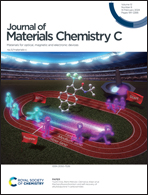A reverse Schmitt trigger with an adjustable hysteresis window implemented by mesoporous silica electrolyte-gated transistors†
Abstract
Mesoporous silica with abundant silanol groups is an ideal proton-conducting material, which suggests that it could act as the gate dielectric layer of an electric double layer (EDL) transistor. In this work, an oxide thin-film transistor (TFT) is prepared by using mesoporous silica as a gate dielectric material. The mesoporous silica film prepared by spin-coating has a high specific capacitance of 2.0 μF cm−2 at 1.0 Hz. Meanwhile, such a low-voltage oxide TFT demonstrates commendable electrical characteristics, such as an ON/OFF ratio >107, a carrier mobility of 24.2 cm2 V−1 s−1, a subthreshold swing of 90.5 mV dec−1, and relatively good device stability. Moreover, due to proton migration/relaxation in mesoporous silica, a resistor-loaded reverse Schmitt trigger based on the TFT features an adjustable hysteresis window. Furthermore, the voltage gain reaches 12.3 at VDD = 3 V. At the same time, when signals with a random noise (±0.2 V) triangular wave and sine wave are input, it can consistently output regular square wave signals, demonstrating excellent filtering performance. This provides an option for the application of mesoporous silica-based materials in electrochemical sensors and neuromorphic systems.



 Please wait while we load your content...
Please wait while we load your content...